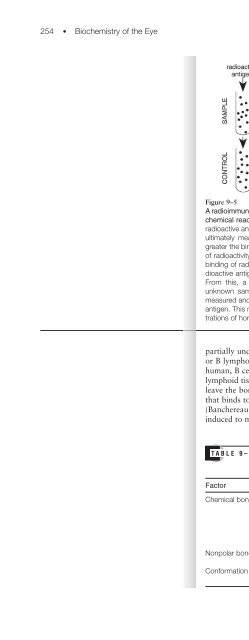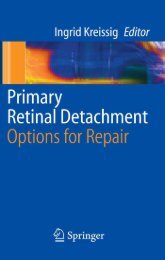- Page 2:
BUTTERWORTH-HEINEMANN An Imprint of
- Page 6:
Acknowledgments I am indebted to th
- Page 10:
disc membrane cytosol N extracellul
- Page 14:
capillary all-trans RETINOL (t) * a
- Page 18:
p53 S p63 p73 G 2 Checkpoints CELL
- Page 22:
Color Plate 9 The Fas receptor mech
- Page 26:
2 • Biochemistry of the Eye Figur
- Page 30:
4 • Biochemistry of the Eye Figur
- Page 34:
6 • Biochemistry of the Eye Figur
- Page 38:
8 • Biochemistry of the Eye press
- Page 42:
10 • Biochemistry of the Eye TABL
- Page 46:
12 • Biochemistry of the Eye TABL
- Page 50:
14 • Biochemistry of the Eye Mayn
- Page 54:
16 • Biochemistry of the Eye Figu
- Page 58:
18 • Biochemistry of the Eye Figu
- Page 62:
20 • Biochemistry of the Eye Figu
- Page 66:
22 • Biochemistry of the Eye Figu
- Page 70:
24 • Biochemistry of the Eye Figu
- Page 74:
26 • Biochemistry of the Eye Figu
- Page 78:
28 • Biochemistry of the Eye proc
- Page 82:
30 • Biochemistry of the Eye TABL
- Page 86:
32 • Biochemistry of the Eye Figu
- Page 90:
34 • Biochemistry of the Eye OH 3
- Page 94:
36 • Biochemistry of the Eye Figu
- Page 98:
38 • Biochemistry of the Eye Figu
- Page 102:
40 • Biochemistry of the Eye Figu
- Page 106:
42 • Biochemistry of the Eye stru
- Page 110:
44 • Biochemistry of the Eye TABL
- Page 114:
46 • Biochemistry of the Eye Figu
- Page 118:
48 • Biochemistry of the Eye Figu
- Page 122:
50 • Biochemistry of the Eye Figu
- Page 126:
52 • Biochemistry of the Eye Berb
- Page 130:
54 • Biochemistry of the Eye Seba
- Page 134:
56 • Biochemistry of the Eye Figu
- Page 138:
58 • Biochemistry of the Eye Figu
- Page 142:
60 • Biochemistry of the Eye Figu
- Page 146:
62 • Biochemistry of the Eye Figu
- Page 150:
64 • Biochemistry of the Eye Figu
- Page 154:
66 • Biochemistry of the Eye Figu
- Page 158:
68 • Biochemistry of the Eye Figu
- Page 162:
70 • Biochemistry of the Eye Figu
- Page 166:
72 • Biochemistry of the Eye Figu
- Page 170:
74 • Biochemistry of the Eye Figu
- Page 174:
76 • Biochemistry of the Eye HO H
- Page 178:
78 • Biochemistry of the Eye deve
- Page 182:
80 • Biochemistry of the Eye Figu
- Page 186:
82 • Biochemistry of the Eye P R
- Page 190:
84 • Biochemistry of the Eye Whik
- Page 194:
86 • Biochemistry of the Eye Figu
- Page 198:
88 • Biochemistry of the Eye Figu
- Page 202:
90 • Biochemistry of the Eye Figu
- Page 206:
92 • Biochemistry of the Eye Figu
- Page 210:
94 • Biochemistry of the Eye Figu
- Page 214:
96 • Biochemistry of the Eye Figu
- Page 218:
98 • Biochemistry of the Eye Figu
- Page 222:
100 • Biochemistry of the Eye Fig
- Page 226:
102 • Biochemistry of the Eye = -
- Page 230:
104 • Biochemistry of the Eye TAB
- Page 234:
106 • Biochemistry of the Eye blo
- Page 238:
108 • Biochemistry of the Eye TAB
- Page 242:
110 • Biochemistry of the Eye Fig
- Page 246:
112 • Biochemistry of the Eye Fig
- Page 250:
114 • Biochemistry of the Eye Fig
- Page 254:
116 • Biochemistry of the Eye nor
- Page 258:
118 • Biochemistry of the Eye Fig
- Page 262:
120 • Biochemistry of the Eye Fig
- Page 266:
122 • Biochemistry of the Eye Fig
- Page 270:
124 • Biochemistry of the Eye Fig
- Page 274:
126 • Biochemistry of the Eye Fig
- Page 278:
128 • Biochemistry of the Eye and
- Page 282:
130 • Biochemistry of the Eye Hec
- Page 286:
132 • Biochemistry of the Eye Wag
- Page 290:
134 • Biochemistry of the Eye Fig
- Page 294:
136 • Biochemistry of the Eye Fig
- Page 298:
138 • Biochemistry of the Eye TAB
- Page 302:
140 • Biochemistry of the Eye Fig
- Page 306:
142 • Biochemistry of the Eye Fig
- Page 310:
144 • Biochemistry of the Eye mem
- Page 314:
146 • Biochemistry of the Eye Fig
- Page 318:
148 • Biochemistry of the Eye Fig
- Page 324:
Lipids • 151 more hydrophilic lip
- Page 328:
Figure 5-22 The processing and tran
- Page 332:
Lipids • 155 This unique and comp
- Page 336:
Lipids • 157 Townsend WM: Congeni
- Page 342:
160 • Biochemistry of the Eye Fig
- Page 346:
162 • Biochemistry of the Eye Fig
- Page 350:
164 • Biochemistry of the Eye Fig
- Page 354:
166 • Biochemistry of the Eye Fig
- Page 358:
168 • Biochemistry of the Eye Fig
- Page 362:
170 • Biochemistry of the Eye HOR
- Page 366:
172 • Biochemistry of the Eye Fig
- Page 370:
174 • Biochemistry of the Eye INN
- Page 374:
176 • Biochemistry of the Eye How
- Page 378:
178 • Biochemistry of the Eye Fig
- Page 382:
180 • Biochemistry of the Eye Fig
- Page 386:
182 • Biochemistry of the Eye TAB
- Page 390:
184 • Biochemistry of the Eye Fig
- Page 394:
186 • Biochemistry of the Eye cel
- Page 398:
188 • Biochemistry of the Eye Lod
- Page 404:
C H A P T E R 7 Nucleic Acids Nucle
- Page 408:
Figure 7-2 Four examples of nucleot
- Page 412:
Figure 7-4 A representation of the
- Page 416:
Figure 7-7 Sequence scheme of daugh
- Page 420:
Figure 7-10 The RNA nucleotide, whi
- Page 424:
Figure 7-12 RNA polymerase must pas
- Page 428:
Figure 7-14 Left side: Functional d
- Page 432:
IF-3 5' A U G 3' (1) 40S ribosome s
- Page 436:
40S ribosome subunit 5' 5' 40S ribo
- Page 440:
5' 40S ribosome subunit 60S ribosom
- Page 444:
Figure 7-22 DNA damage to rat lens
- Page 448:
overstated due to the presence of t
- Page 452:
Figure 7-25 Diagram of retinoblasto
- Page 456:
Figure 7-29 Protein zinc finger att
- Page 460:
(wild type-Cryga gene) CAGCAGTGGATG
- Page 464:
Figure 7-31 Diagram of a herpes vir
- Page 468:
Figure 7-34 Acycloguanosine and its
- Page 472:
Nucleic Acids • 225 tion, the pot
- Page 476:
References Nucleic Acids • 227 Al
- Page 480: Nucleic Acids • 229 Watson, JD, C
- Page 486: 232 • Biochemistry of the Eye Fig
- Page 490: 234 • Biochemistry of the Eye Fig
- Page 494: 236 • Biochemistry of the Eye Fig
- Page 498: 238 • Biochemistry of the Eye Fig
- Page 502: 240 • Biochemistry of the Eye Fig
- Page 506: 242 • Biochemistry of the Eye Fig
- Page 510: 244 • Biochemistry of the Eye Na
- Page 514: 246 • Biochemistry of the Eye app
- Page 518: 248 • Biochemistry of the Eye Ehi
- Page 522: 250 • Biochemistry of the Eye Fig
- Page 526: 252 • Biochemistry of the Eye Fig
- Page 532: Figure 9-6 The development of plasm
- Page 536: TABLE 9-3 ➤ (1) tears collected w
- Page 540: Figure 9-8 The initial reactions of
- Page 544: Figure 9-11 Peptide binding complex
- Page 548: Figure 9-14 Diagram of the chemotac
- Page 552: Figure 9-17 Formation of free radic
- Page 556: Ocular Immunochemistry • 267 unab
- Page 560: Ocular Immunochemistry • 269 McBr
- Page 566: 272 • Biochemistry of the Eye Fig
- Page 570: 274 • Biochemistry of the Eye Fig
- Page 574: 276 • Biochemistry of the Eye Fig
- Page 578: 278 • Biochemistry of the Eye Exp
- Page 582:
280 • Biochemistry of the Eye mec
- Page 586:
282 • Biochemistry of the Eye Spa
- Page 590:
284 • Biochemistry of the Eye Agr
- Page 594:
286 • Biochemistry of the Eye Can
- Page 598:
288 • Biochemistry of the Eye Cor
- Page 602:
290 • Biochemistry of the Eye End
- Page 606:
292 • Biochemistry of the Eye Gly
- Page 610:
294 • Biochemistry of the Eye Imm
- Page 614:
296 • Biochemistry of the Eye Met
- Page 618:
298 • Biochemistry of the Eye dur
- Page 622:
300 • Biochemistry of the Eye Pro
- Page 626:
302 • Biochemistry of the Eye Shi
- Page 630:
304 • Biochemistry of the Eye Uns
- Page 634:
306 Answers to Problems Chapter 1 1
- Page 638:
308 • Biochemistry of the Eye 5.
- Page 642:
310 • Biochemistry of the Eye 3.
- Page 646:
312 • Biochemistry of the Eye the
- Page 650:
314 • Biochemistry of the Eye Car
- Page 654:
316 • Biochemistry of the Eye H H
- Page 658:
318 • Biochemistry of the Eye Pro





